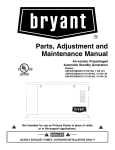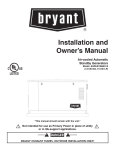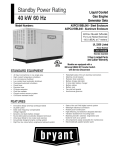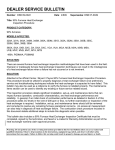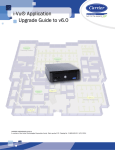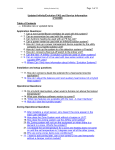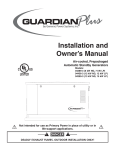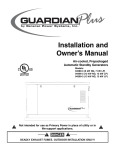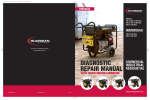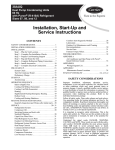Download Bryant ASPAS1BBA007 Product information guide
Transcript
AUTOMATIC HOME STANDBY GENERATORS Product Information Guide CONVENIENT, AUTOMATIC BACKUP POWER For more than a century, Bryant has gained a nationwide following of homeowners who appreciate products of high quality, value and reliability. It’s a reputation that we are proud of, the driving force behind our continuous effort to develop products that not only deliver comfort, but peace of mind. And, that’s why were excited to offer the Automatic Home Standby Generator. The Automatic Home Standby Generator is the convenient and totally automatic way to provide electricity to your home when the utility power is interrupted. Why buy a Home Standby Generator (HSB)? . . .4 What is a Home Standby Generator? . . . . . . . . .7 Pre-packaged Air-cooled System . . . . . . . . . . . .8 How the Home Standby Generator Works . .10-11 How to Size a Generator . . . . . . . . . . . . . . . . . 12 Easy Air-cooled Sizing Chart . . . . . . . . . . . . . . 13 Air-cooled Generators . . . . . . . . . . . . . . . . .14-15 Liquid-Cooled Generators . . . . . . . . . . . . . .16-17 Installation Preparation . . . . . . . . . . . . . . . . . . .18 Step-by-Step Installation . . . . . . . . . . . . . . .19-22 Frequently Asked Questions . . . . . . . . . . . . .23-25 Disadvantages of Portable Generators . . . . . . .26 3 TABLE OF CONTENTS Table of Contents Why buy a Home Standby Generator? Any customer who wants backup power for residential or light commercial use is a potential BRYANT purchaser. Customers shop for one of two reasons: 1) They have experienced a power outage in the past, or 2) They have learned about the uncertain future of their electrical power supply. COST JUSTIFICATION • Increase the value of your home, improve the quality of your life, and protect your family. • People are willing to spend thousands of dollars on plasma screen tv’s. For about the same amount of money they would be protecting their family from the dangers of an unexpected power outage. Accidents can occur due to: • lack of lighting • water pipes freezing - then bursting • flooded basements • food spoilage • Many people work out of their homes. How much money would they lose if they were without power for 2 or 3 days? • Unlike a portable generator, installing a BRYANT standby generator will increase the value of your home just like a deck. Throughout the life of your home the BRYANT will more than pay for itself. 4 FACTS ABOUT YOUR POWER SUPPLY • Severe weather patterns have increased dramatically over the past few years. • hurricanes • ice storms • thunderstorms • heatwaves • floods The power outages caused by these weather events are occurring more frequently and lasting longer. • Increased demand for air conditioning during frequently occurring heat waves create more blackouts and brownouts than all other weather patterns combined. • The nation's power grid is making the public increasingly uneasy about the reliability of their power supply. The '03 Northeast Blackout left over 50 million people without power. In this electronic age we are becoming more and more reliant on electricity to function in our daily lives. • Demand for electricity is outpacing supply in certain parts of the country. Power companies are not building enough plants to keep pace with demand nor are they replacing the aging transmission lines. • Power companies are so concerned about the situation that they are now selling home standby generators to the public themselves. 5 WHY BUY A HSB? The security, safety, and assurance that you will never be without power is priceless. Imagine how much your peace of mind is worth, knowing that your home and family are protected from power outages if you are not there to help them. 6 A home standby generator is a pre-packaged, fully automatic generator system. The system is designed to supply electrical power to pre-selected emergency circuits that supply a homes lighting, heat, air conditioning, water and appliances. The home standby generator produces electricity without the customer having to lift a finger. • No gasoline cans • No extension cords • No manual pull starts THE HOME STANDBY ADVANTAGE • When utility power fails the automatic transfer switch (ATS) signals the generator to produce electricity for the pre-selected circuits in your home. • At the same time the (ATS) safely closes off the utility line. (NOTE: If the utility line is not closed off you will allow dangerous electrical "back feed" to travel out of your home to the neighboring homes and the utility lines. That could prove fatal to someone repairing the utility line.) • When power does return, the switch then disconnects the generator and re-opens the utility line. HOME FUEL SUPPLY • Uses your own natural gas or LP gas system. • This provides you with a much longer continuous run time and unlimited run time in the case of natural gas. 7 WHAT IS A HSB? What is a Home Standby Generator? Pre-packaged Air-cooled System Air-cooled models only. A. 30’ pre-wired flexible conduit for hook-up to outdoor connection box A B. Automatic transfer switch with built-in load center C. 2’ pre-wired conduit for easy connection to the main electrical distribution panel B C D. Outdoor connection box prewired to generator controls and main line circuit breaker E. Flexible fuel line for connection from rigid gas pipe to generator fuel inlet D F. Composite mounting pad eliminates the need to pour concrete G. Step-by-Step installation guide 8 E G F WHAT’S INCLUDED: EASY INSTALLATION Pre-packaged & pre-wired 120V GFCI OUTLET & 12V DC RECEPTACLE POWER SUPPLY EVERYDAY BRYANT air-cooled models feature an exterior mounted 120V GFCI duplex outlet and internal 12V DC outlet to increase the functionality of the generator. During an outage or while operating the generator manually, the outlets can power outdoor lights or recharge cell phones. With the flip of a switch you can run power tools and lawn & garden tools. 9 How the Home Standby Generator Works 1. The BRYANT ATS monitors incoming voltage from the utility line around the clock. 2. When utility power is interrupted, the transfer switch immediately senses the problem and signals the generator set to start. 3. The transfer switch then safely closes off the utility line and simultaneously opens a new power line from the generator. This automatic switch action will stop any “back feed” of power to the 10 4. Within seconds your BRYANT system begins supplying electricity to the circuits you have chosen to be powered in a utility failure. The lights and appliances on these circuits are again functioning normally. The transfer switch continues to monitor the utility line conditions in order to retransfer back to the utility source when it returns. 5. When the transfer switch senses that utility line voltage has returned at a steady state it retransfers the electrical load back to the utility line automatically and resumes monitoring for subsequent loss. The generator will continue to run for an engine cool down period of several minutes while the entire system stands ready for the next power outage. 11 HOW IT WORKS utility line or neighboring houses. “Back feed” of electricity to the utility is extremely dangerous and could short circuit wiring in your home and neighboring homes. “Back feed” of electricity could even be fatal to a worker repairing downed power lines. Safely closing off the utility line becomes the most important feature of the transfer switch. How to Size a Generator The number of circuits the customer needs protected during a power outage will determine the size of generator. The more coverage needed, the more circuits needed. A 7 kW AIR-COOLED MODEL WITH 8 CIRCUITS CAN RUN: Kitchen (2 circuits), Furnace, Family Room, Bedroom, Bathroom, Sump or Well Pump and Garage Air-cooled generators are intended to power a home’s essential items and come equipped with an automatic transfer switch available with 8, 10 or 12 circuits. Liquid-cooled generators are intended for larger residential or light commercial applications requiring greater coverage of circuits. These units and transfer switches provide up to whole house power. 12 SIZING A GENERATOR Easy Air-Cooled Sizing Chart Circuits - 30 Amp/240V Circuits - 20Amp/240V Circuit - 20Amp/120V Circuit - 20Amp/120V Circuit - 20Amp/120V Circuit - 15Amp/120V Circuit - 15Amp/120V Circuit - 15Amp/120V Circuit - 15Amp/120V Circuit - 15Amp/120V AIR CONDITIONER* KITCHEN FAMILY ROOM REFRIGERATOR LIGHTS/BEDROOM BATHROOM SUMP PUMP FURNACE HOME OFFICE GARAGE Automatic transfer switch provides the following circuit breaker configuration: 2 2 1 1 1 1 1 1 1 1 • 7 kW LPG 6 kW NG Connect up to 8 Circuits in your home 12 kW LPG 12 kW NG Connect up to 10 Circuits in your home 15 kW LPG 13 kW NG Connect up to 12 Circuits in your home • • • • • • • • • • • • • • • • • • • • • • • • *Limited to air conditioner’s protected by 30 Amp/2-Pole circuit breakers (normally two ton or less). Rooms and appliances are shown as example only. All items may not be able to run simultaneously. 13 Air-cooled Generators Model # Rated Power (LPG/Natural Gas) kW Voltage (single phase) Amps @ 120/240V LPG Amps @ 120/240V NG Engine/Alternator RPM Displacement/HP Fuel Consumption @ full load Liquid Propane Gas cu. ft/hr (gal/hr) Natural Gas cu. ft/hr Dimensions (L”x W”x H”) Generator Weight (lbs.) Automatic Transfer Switch Circuits ASPAS1BBA007 7/6 120/240V 58.3/29.2 50.0/25.0 3600/3600 410cc / 14.5 HP 54 (1.47) 119 48 x 24 x 28.25 375 100 Amp NEMA 1 8 Controls Start/Stop Control Cyclic cranking: Automatic Low Oil Shutdown High Temperature Shutdown Overspeed Shutdown Overspeed Protection Automatic Voltage Regulator Engine Warm-Up (Before transfer to generator) Engine Cool-down (After transfer back to utility) Safety Fuse Starter Lockout 2.5 Amp Timed Trickle Battery Charger Mode Switch: AUTO: Automatic start on utility failure/ 7 days exerciser OFF: Stops unit. Power is removed. Control and charger still operate. MANUAL/TEST: Unit remains running. If utility fails, transfer to load takes place. 14 AIR-COOLED ASPAS1BBA012 12/12 120/240V 100.0/50.0 100.0/50.0 3600/3600 763cc / 26 HP ASPAS1BBA015 15/13 120/240V 125.0/62.5 108.3/54.2 3600/3600 992cc / 30 HP ASPAX1BBA015 15/13 120/240V 125.0/62.5 108.3/54.2 3600/3600 992cc / 30 HP 76 (2.08) 215 48 x 24 x 28.25 470 100 Amp NEMA 1 10 88 (2.40) 220 48 x 24 x 28.25 487 100 Amp NEMA 1 12 88 (2.40) 220 48 x 24 x 28.25 487 Not included. N/A 7 sec. on, 7 rest. 90 sec. total cycle time Standard Standard (72 Hz) Standard Standard 10 seconds 1 minute Standard Starter cannot re-engage until 5 sec. after engine has stopped. Standard PLEASE NOTE: This product requires installation involving permanent outdoor placement, electrical wiring and fuel source connections. Natural gas pressure of 5” - 7” of water column (0.18 to 0.25 psi) LP gas pressure of 11”-14” of water column (0.4 to 0.5) is required. 15 Liquid-cooled Generators Model # Rated Power (LPG/Natural Gas) kW Voltage (single phase) Amps @ 120/240V LPG Amps @ 120/240V NG Engine/Alternator RPM Engine Displacement Fuel Consumption @ full load Liquid Propane Gas cu. ft/hr (gal/hr) Natural Gas cu. ft/hr Dimensions (L”x W”x H”) Generator Weight (lbs.) Automatic Transfer Switch (NEMA 3R) ASPCS1BBL025 25/25 120/240V 208.3/104.2 208.3/104.2 1800/1800 In-line 4-cyl. 2.5L 138 (3.76 343 71 x 29.5 x 36 1045 I------------------------------ Enclosure* Steel *The aluminum, corrosion resistant enclosure stands up to harsh conditions, which is extremely Controls Start/Stop Control Cyclic cranking: Automatic Low Oil Shutdown High Temperature Shutdown Overspeed Shutdown OverspeedProtection Automatic Voltage Regulator Engine Warm-Up (Before transfer to generator) Engine Cool-down (After transfer back to utility) Safety Fuse Starter Lockout 2.5 Amp Timed Trickle Battery Charger Mode Switch: AUTO: Automatic start on utility failure/ 7 days exerciser OFF: Stops unit. Power is removed. Control and charger still operate. MANUAL/TEST: Unit remains running. If utility fails, transfer to load takes place. 16 LIQUID-COOLED ASPCA1BBL025 25/25 120/240V 208.3/104.2 208.3/104.2 1800/1800 In-line 4-cyl. 2.5L ASPCS1BBL040 40/37 120/240V 333.3/166.6 308.3/154.2 1800/1800 Generac® V-6 3.9L ASPCA1BBL040 40/37 120/240V 333.3/166.6 308.3/154.2 1800/1800 Generac® V-6 3.9L 138 (3.76) 221.5 (6.07) 221.5 (6.07) 343 550 550 71 x 29.5 x 36 77 x 34 x 45 77 x 34 x 45 970 1658 1541 -----200 Amp with service disconnect----------------------------------I Aluminum Steel Aluminum important in coastal areas where the sea air can destroy most metals. 7 sec. on, 7 rest. 90 sec. total cycle time Standard Standard (72 Hz) Standard Standard 10 seconds 1 minute Standard Starter cannot re-engage until 5 sec. after engine has stopped. Standard PLEASE NOTE: This product requires installation involving permanent outdoor placement, electrical wiring and fuel source connections. Natural gas pressure of 5” - 14” of water column (0.18 to 0.5 psi) LP gas pressure of 11”-14” of water column (0.4 to 0.5) is required. 17 Installation Preparation Air-cooled models only. ITEMS YOU NEED: • Battery should be 12 volt, negative ground with top posts. ASPAS1BBA007: Minimum 350 CCA at 0° F (Group 26) ASPAS1BBA012 & ASPAS1BBA015: Minimum 525 CCA at 0° F (Group 26) • 40 Amp (7 kW) or 70 Amp (12 kW and 15 kW) double pole circuit breaker (Must be compatible with your main distribution panel.) • Grounding rod with grounding strap • Crushed stone or pea gravel (approximately 10-12 cubic feet) • Black poly-film or other vegetation blocking fabric (51/2' x 5') • Silicone caulk • Pipe sealant (suitable for gaseous fuel connections) • Fasteners (to mount external connection box and automatic transfer switch with built-in load center) TOOLS REQUIRED: Drill, drill bits, hole saw (type and length will be determined by the materials you will be drilling and cutting), open-end wrenches or adjustable wrenches, socket wrenches or nut drivers, standard and Phillips screwdrivers, level, sledge hammer, channel-lock pliers, spade shovel, pencil and safety goggles. 18 OBTAIN PERMITS 1. Visit your local municipal office to obtain necessary permits for installation. FUEL CONNECTION 2. Arrange to have a natural gas or LP gas fuel connection, complete with shut-off valve, located within 1' of generator fuel inlet. PREPARE LOCATION 3. Clear an area 5-1/2 feet by 5 feet minimum of grass and vegetation to a depth of 5 inches. This includes the distance the generator should be set away from any structure (3 feet) and 6 inches beyond the width and length of the generator mounting pad (48" L x 24" W). NOTE: Local codes may supercede these requirements. 4. Connect 1' flex fuel line to gas piping and generator fuel inlet. Check for leaks with soapy water. 5. Drill a 1-3/4" diameter hole through exterior wall to inside using hole saw. 6. From the interior of the house, feed end of 30' conduit from automatic transfer switch through wall to outside. 19 INSTALLATION Step-by-step Installation 7. Remove the knockout in the lower right corner of the external connection box. From the rear of the connection box, feed wires & 4-pin plug into box. Slip the lock nut over the wires and plug and tighten securely onto conduit coupling. Match and connect wires by color to lugs with existing wires. Snap together the 4-pin connector. Loosen the nut from the grounding lug and attach ground wire (green) from the conduit. Reinstall the nut and tighten. Mount external connection box over pre-drilled hole. Seal around the conduit with insulation and silicone caulk. KNOCK OUT GROUND SCREW 8. Install the automatic transfer switch within 1' of your main electrical distribution panel. Secure excess conduit to walls and/or ceiling. Switch off all circuit breakers in the emergency load center. 9. In this step you will be relocating circuits to be powered by the generator from your main panel to the emergency load center. After removing the proper size knockout, remove the threaded lock nut from connector and feed all wires from 2’ conduit into your main electrical distribution panel. Slip the lock nut over wires from the inside of the main panel and tighten onto connector securely. 20 1’ The outer diameter of the threaded end is: 15/16” (7 & 12 kW) or 1-3/8” (15 kW) INSTALLATION CONT. 10.(All wires are color coded and labeled with amperage and voltage to make connection easy.) Simply disconnect the black wire from the circuit breaker in the main panel and reconnect it to the appropriate wire from the emergency load center with a wire nut. Repeat this step for the rest of the circuits to be run by the generator. 11. Install the 40 Amp or 70 Amp double pole circuit breaker into the main electrical distribution panel. This circuit breaker must be compatible with your main electrical distribution panel. Switch off the circuit breaker. Connect white wire to the main distribution panel neutral bar. Connect the green wire to the main electrical panel ground bar. Connect the black and red wires to the 40 Amp or 70 Amp double pole circuit breaker. All indoor wiring is now complete. DON’T FORGET... • Remove fuses in control panel • Connect starting battery • Open fuel valve • Reinstall fuses in control panel • Set generator mode switch to “AUTO” • Set exercise timer - Switch on service main circuit breaker, the circuit breakers in your main panel and circuit breakers in the load center. FUEL VALVE EXERCISER SWITCH 21 Frequently Asked Questions Q How long does it take to install a generator system? A The air-cooled 7 kW, 12 kW and 15 kW, which come equipped with a comprehensive installation kit, can take as little as 4 hours. The liquid-cooled will normally take up to 14 hours, over 2 days. The reason is that while the air-cooled units include a composite mounting pad, the liquid-cooled units, because of the added weight, must be placed on a stronger mounting surface. Concrete slabs are poured and need one day to set properly, which accounts for some of the additional installation time. If the installer can source a prefabricated mounting pad that will meet the weight requirements, the installation time will be reduced accordingly. The length of time is based on a “typical application”. It does not apply to extended runs of conduit or gas piping or placement of a unit away from the incoming gas or electrical service. Q How much fuel do the units use? A Use generator reference chart pages 14-17. Q Sizing your generator: Air-cooled or Liquidcooled? A Air-cooled: The BRYANT air-cooled generator comes equipped with an automatic transfer switch and emergency distribution panel to power specific circuits in your home. The 7/6 kW is 22 FAQ- HOME STANDBY equipped with 8 circuits, the 12/12 kW with 10 circuits and the 15/13 kW comes equipped with 12 circuits integrated in the transfer switch. You can determine your BRYANT size requirement by identifying what circuits from your home's main distribution panel you wish to supply with back-up power. Simply choose the circuit from your home that you wish to provide with BRYANT power and match it to a same amperage circuit on the BRYANT transfer switch. A 15 Amp circuit for your living room can be matched to a 15 Amp circuit on your BRYANT transfer switch and emergency distribution panel. Liquid-cooled: The only completely accurate way is to have an electrician apply an amp meter to the circuits or appliances that are intended to operate under backup power. It is recommended that the amp draw be measured as the appliance “starts up” when that appliance uses an inductive or resistive motor. Q Why aluminum enclosures? A In coastal communities, salt air can destroy steel in a short period of time. Aluminum is corrosion resistant, so it prolongs the life and look of the generator. Q What do you do if the customer has 200 Amp service in their home? A It is always recommended that emergency circuits be isolated into a sub panel with its own breakers. That way there isn’t any possibility that the generator will be overloaded and the system is able to operate as intended truly automatic. 23 Q What is the maintenance schedule? A The maintenance schedule is in the owner’s manual. The schedule varies between the aircooled and the liquid-cooled models. Q What is the expected life of the engine? A A properly maintained engine should provide over 20 years of operation under standby conditions. Q How much oil does the engine crankcase hold? A Air-cooled: (7 kW) = 1.5 qts Air-cooled: (12 kW, 15 kW) = 1.7 qts Liquid-cooled: 25 & 40 kW = 4.5 qts. Q What type of oil is recommended? A For air-cooled units: After the break in oil, an all season synthetic oil 5W-30 should be used. API Service Class SG, SH or SJ should be used in all cases. The recommended oil for the liquid-cooled units is 15W-40. All oils should be high detergent oil that meets or exceeds API Service Class SG, SH or SJ requirements for gasoline engines. Q What is the required water column for installation? A Air-cooled generators require natural gas pressure of 5” - 7” of water column (0.18 to 0.25 psi) or LP gas pressure of 11”-14” of water column (0.4 to 0.5). Liquid-cooled generators require natural gas pressure of 5” - 14” of water column (0.18 to 0.5 psi) or LP gas pressure of 11”-14” of water column (0.4 to 0.5). 24 Q What kind of warranty does Bryant provide? A The home standby generator is backed with a 2year limited parts and labor warranty. Extended warranties are also available. Q Who do I contact if I have further questions? A Please call 1-877-901-2792 or e-mail at [email protected]. Q Is there technical training available for these products? A Yes. Please visit www.HVACPartners.com for the most current offerings. 25 FAQ- HOME STANDBY Q Propane tanks are usually rated by pounds. Is there a conversion that can be applied to the fuel consumption numbers? A Yes. For general conversion, propane weighs 4.24 lbs. per gallon. 1 lb. = 8.58 cu ft. 1 gallon = 36.39 cu ft. Disadvantages of a Portable Generator • You have to find the generator. How do you do that? It’s dark. Does it have gasoline in it? Do you have a full gas can on hand? Is the oil in it? Does it start? Do you have to pull-start repeatedly? • Has the unit been stored for a long period or dropped after it was last used? That could result in the loss of the residual magnetic field. • You must physically move the generator from storage to the area where you will manually start it. You hope it starts. While it runs you will need to fill up frequently during an extended outage. How much fuel would you have to store for a 10 day outage? 100 gallons? • You must connect the generator to the electrical service outlet if you have had one installed. Do you know how to connect it? If not, start looking for the extension cords; assuming it’s not a flood. • You must manually transfer electrical loads to restore power to selected circuits. You must make certain that the circuits are isolated from the rest of the electrical panel. You must be absolutely sure that you have disconnected the service main breaker. That is the only way to prevent dangerous “back feed” from the generator to neighboring houses and the utility line when power returns. • When utility power returns you must begin disconnecting, reconnecting and putting things back in storage. 26 CONTACT US: 1-877-901-2792 [email protected] [email protected] Visit our website www.bryant.com Manufacture reserves the right to discontinue or change at any time, specifications or designs without notice or without incurring obligations. P/N0F6738 ASPAS07- 2PG (Replaces ASPAS07-1PG) 10.05





























